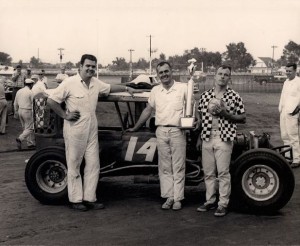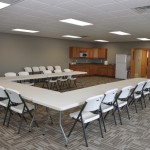By Chad Meyer
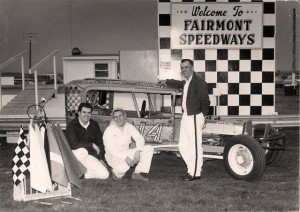
The #14 team ready for action at Fairmont Raceway. Ron Barton (left), Roger Hendrickson (center), and Jim Edgington were a dominate team in 1967. Hendrickson joins his teammates as an inductee into the Kossuth County Racing Hall of Fame.
Though he came from a drag racing background, Roger Hendrickson left his mark on the dirt ovals that dot Iowa and Minnesota. After meeting up with fellow Algona natives Jim Edgington and Ron Barton, the trio soon set out on a path of dirt oval track racing success that has been rivaled by few.
Hendrickson, who was a terrific fabricator, was asked by Kenny Holcomb Sr. in 1963 to help build a 1950 Hudson Pacemaker that was to have Darreld Bunkofske as the driver. When Bunkofske wasn’t able to drive the car, Holcomb sought out Edgington to man the controls of the No. 78.
The next year, Larry Reefer asked Barton for some engine help on his race car. Barton brought the engine out of his family car and Hendrickson came along to help on the chassis.
In 1965, Barton, Hendrickson, and Edgington pooled their resources and built a modified. A grand total of $850 was spent constructing their first car together, which was built from scratch. They raced frequently that first year together, competing mostly at Algona, Fairmont and Jackson, MN. They also competed at track promoter Lamont Wellendorf’s other race tracks, including Cresco, Webster City and Mason City.
At the conclusion of that first season together, the new team finished third in the points at Jackson Speedway. A year later at Jackson and Fairmont, they climbed to second in the season ending standings, completing the year behind champion Marv DeWall.
Though the team had been successful right out of the gate in their first year, he credits a conversation over a few beverages at the Pine Room in Algona, with Knoxville Raceway hot shoe Norm Wiemers that got them pointed in the right direction with car set-ups in 1966. Hendrickson listened intently; making mental notes about tire stagger, caster/camber, front end geometry and toe out to try on their car.
Hendrickson applied every trick he learned from that conversation, except Wiemers advice of toeing the front wheels out about a 1/8th of an inch. The car handled better, but the gains on the track were only marginal. During the feature event though, Edgington got caught in an on track tangle that toed the wheels out by accident. After getting back in the race, Edgington was driving faster than he ever had before, making them believers in how to set the car up from that point forward.
The team reached a new high in 1967, earning track championships at both Jackson Speedway and at the Fairmont speed plant. Impressively, they did it with two different drivers. Edgington was able to snare a ride at the famed Knoxville, IA raceway on Saturday nights. Barton and Hendrickson tabbed Les Wildin to drive the No. 14 at Jackson in his place, earning the season championship. Edgington returned to the car on Sunday nights, garnering the Fairmont Raceway championship in the same car.
Before the 1968 season, Hendrickson scratched out ideas for a new car that featured a cross-torsion rear suspension. The team struggled in the first half of the season with handling issues. They recovered well in the second half, discovering that the rear suspension needed stronger bars supporting the cross-torsion system. At season’s end, they finished third in points at Fairmont and Jackson.
Using a Don Edmunds modified chassis blueprint, Hendrickson helped have the team ready for the 1969 season. After finishing second in points to Daryl Dawley at Jackson Speedway and second at Fairmont, they went north to claim the Minnesota state modified championship on the pavement track at the Minnesota State Fair.
1970 proved to be the pinnacle for No. 14 team. Prior to the season, Hendrickson massaged the Edmunds inspired frame to accommodate the new shorter 85” wheelbase now allowed in the rule book. Once again, they dominated, capturing the season point championships at the Fairmont and Jackson speedways.
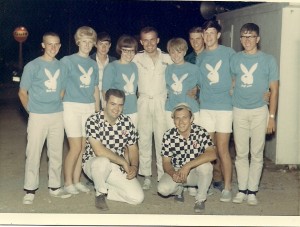 As the conclusion of the season, the team trekked north for the Minnesota State Fair races. In 1970, the format for the races on the asphalt was made into a two day show. After winning their qualifying feature on day one, Edgington was set start the 50 lap championship main on the outside front row, alongside rival Daryl Dawley.
As the conclusion of the season, the team trekked north for the Minnesota State Fair races. In 1970, the format for the races on the asphalt was made into a two day show. After winning their qualifying feature on day one, Edgington was set start the 50 lap championship main on the outside front row, alongside rival Daryl Dawley.
Though the team was the defending champion of the event, this was the first time they would race 50 laps on asphalt. Lacking the tires necessary to last all 50 laps, it was Hendrickson who helped save the day.
A day earlier, Hendrickson had made quick friends with a local tire dealer who had provided essential set up tips on qualifying day. Concern over the current tire inventory lasting all 50 laps was not lost on the team. Unwilling to buy the suggested Firestone right front tire for just one race, the local tire dealer offered a solution, win the race and the tire is free.
In the main event, Edgington did just that as he got the jump on Dawley. He led the entire distance, holding him off to post their second win in a row in the Minnesota State Championship during the State Fair.
Each of the three partners brought something unique and the entire team fed off each other. Barton had a knack for putting engines together and getting good power out of each creation. Edgington’s skills as a race car driver blossomed during their switch to modifieds and according to Barton; the unsung hero of the team was Hendrickson. Barton felt there wasn’t anything he could not assemble or build for a race car and whatever ideas they come up with to make the car faster, they could collectively make it happen.
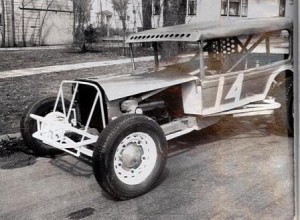 Looking back, Hendrickson says he is most proud of the Fairmont and Jackson Speedway track championships earned against the tremendous competition. He says the team was also very proud of winning the Minnesota State Fair championships, despite having no prior experience on asphalt tracks. Other highlights during that era included winning the Tri-State (Clay County Fair, Spencer, IA) championships in 1966, 1967, 1969, 1970.
Looking back, Hendrickson says he is most proud of the Fairmont and Jackson Speedway track championships earned against the tremendous competition. He says the team was also very proud of winning the Minnesota State Fair championships, despite having no prior experience on asphalt tracks. Other highlights during that era included winning the Tri-State (Clay County Fair, Spencer, IA) championships in 1966, 1967, 1969, 1970.
After 1970, the team stopped fielding modifieds as Edgington went on to pursue his career in sprint cars and as a track promoter. Hendrickson began pursuing other interests. He stayed close to the sport, though, helping at Fairmont Raceway for promoter Edgington
With Hendrickson’s ingenuity and fun-loving attitude, they were often on the leading edge of innovation and put a premium on fun at the race track. The team left behind a legacy of modified domination that was unrivaled by most teams of the day.
Today, Hendrickson is retired and resides in Fairmont, Minnesota. He is very thankful for the support of his wife Julie (and sons Steve and Eric), who he says sacrificed a lot while he chased his dreams in racing and says he will most likely never be able to make it up to her.
Roger Hendrickson joins six others as 2012 inductees into the Kossuth County Racing Hall of Fame.
